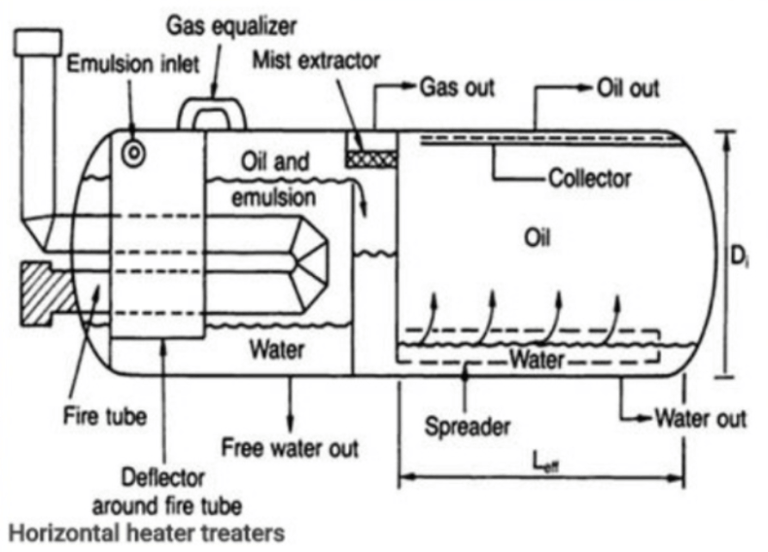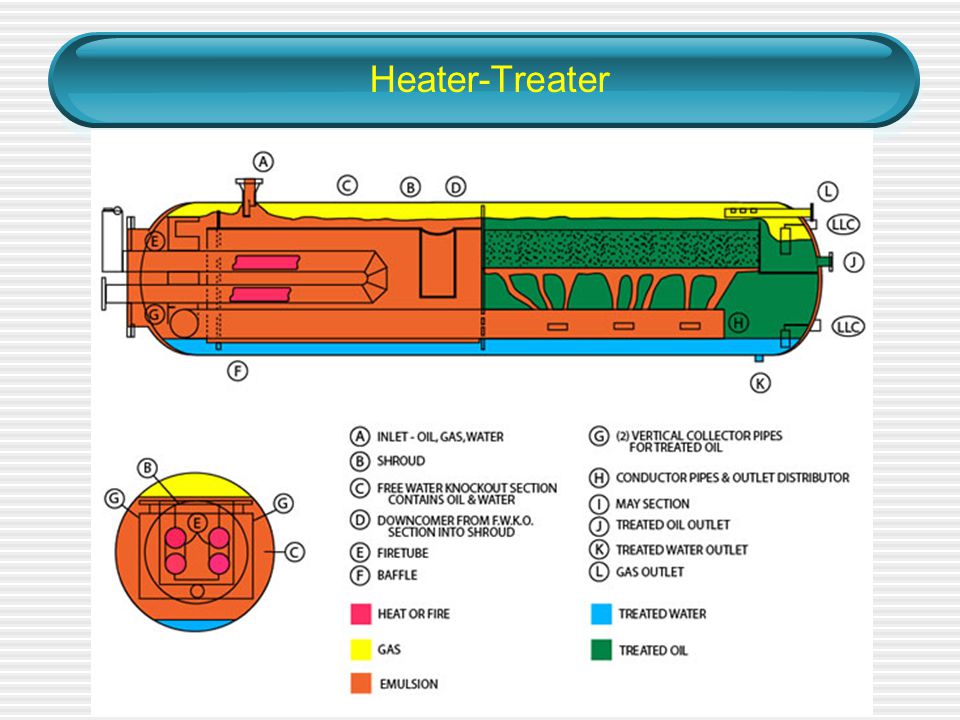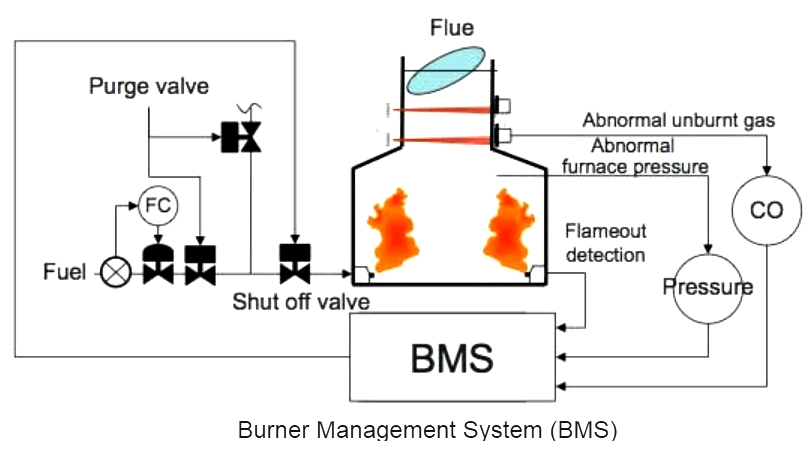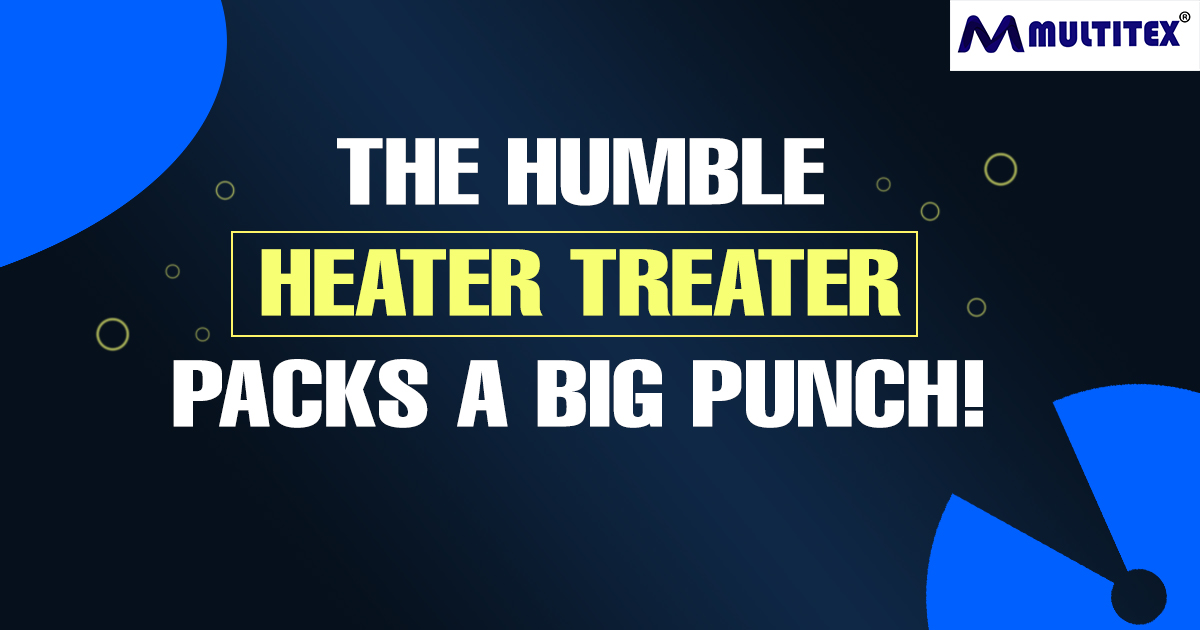Introduction
Crude oil is a naturally occurring petroleum product, made of hydrocarbon deposits and organic materials. It is a fossil fuel that is a yellowish-black liquid that needs to go through various stages of refinery and processing before it becomes useful end-products such as petrol, diesel, and other forms of petrochemicals.
The formation fluid that flows out to the surface from an oil well from the reservoir is called the production fluid and is a mixture of oil, gas, and water. The oil then has to be extracted from this mixture to result in usable end-products.
This separation is done using the heater treater.
What is a heater treater?

The heater treater’s main function is to heat the crude oil/water to break down the emulsion received from upstream separators and facilitate efficient separation by gravity, heating, and electrostatic action before sending crude oil and separated effluent to the storage tank. The main principle of the heater treater is to raise the well fluid temperature to 75-80 ᵒC to promote the separation of oil and water in both the primary and secondary sections of the heater treater.
A heater treater is a vessel that is designed to heat production fluid. When the production fluid is heated, the process of separation is accelerated. The heater treater is typically found in the upstream sector of the oil refining process. It is used for the treatment of emulsion (oil, water, gas). The reason these elements are separated is to make them more valuable to the end-user. The main objective of this entire process is to make sure the natural resource of oil is attractive to the buyer.
How does the heater treater work?
There are four sections in the heater treater and they perform the following functions –
- Degassing
- Heating
- Differential oil control
- Coalescing
Degassing
The untreated crude enters the degassing section through the inlet. The gas vents into the gas collection line which has a mist extractor. The produced water moves to the bottom of the vessel and is removed from an outlet. The emulsion passes into the heating section to separate the free water and solids
Heating
In the heating section, the temperature for treating is maintained around 98.6 – 158 °F (37 – 70 ° C) depending on the viscosity of the crude. The purpose of this section is to help break up the emulsion as well as reduce the crude viscosity. The oil moves into the oil surge chamber without the emulsion.
A Natural / Forced draft Burner is used for heating purposes.
Differential oil control
Once the emulsion is treated with heat, the viscosity of the oil reduces and the lighter oil passes into an oil surge chamber which contains a differential floating device that helps in regulating the oil level. Oil is then removed via an outlet and stored separately for further processing or sale.
Coalescing
The coalescing section includes an electrostatic device that induces droplet coalescence by passing an alternating current through the oil and emulsion mixture. The water molecules break away from the emulsion and collide again to form larger droplets to finally settle down at the bottom of the tank due to gravitational force. The oil that gets separated in this process is removed via a separate outlet pipe.
Types of heater treaters
There are two types of heater treaters, the horizontal heater treater, and the vertical heater treater. Both these types of treaters are used for the separation process. So why do we have two different types of heater treaters if they are doing the same job?
Let’s find out why.
Horizontal heater treater
The horizontal heater treater has a specific role to play in the separation process. This type of design is specified by the crude oil producer, especially if they are going to handle higher volumes of fluid. In this type of treater, the burner tube has a larger surface area contact with the emulsion (a mixture of oil, gas, and water), which allows a higher flow rate when compared to the vertical heater treaters. The horizontal treater also has mechanical dump valves to operate the equipment.

Vertical heater treater
The other components of the heater treater
The gas back pressure valve
This type of control valve, also called the back-pressure valve, is used to manage the pressure on the production vessels like treaters, separators, and free water knockouts. They release the upstream pressure when the pre-assigned point is reached.
Thermostat
Thermostats are devices that help detect temperature changes and help maintain a constant temperature of an enclosed area/ vessel. For effective separation to occur, the temperature of the vessel is essential. If the vessel is not hot enough, proper separation of oil, gas, and water will not occur and will result in the low quality of the end product. The thermostat is usually connected to relays, valves, and switches and generates electrical signals when the temperature exceeds or falls below the required value.
Burner valves
Burner valves are helpful in controlling the combustion process that happens when the gas flows into a tube and mixes with air when the switch to the main gas line is turned on. This ensures the required reaction takes place in a controlled manner.

Burner Management System
When dealing with high temperatures of heat, a burner management system is required to control this heat, especially in a production vessel like a heater treater. It is essential to keep a constant temperature in the heater for ensuring a successful separation process. On the one hand, you don’t want very high temperatures, but at the same time, if the temperature is not appropriate enough, the separation process will not be effective.
Irrespective of whether it is a horizontal or vertical treater, all treaters are considered to be three-phase separators. A three-phase separator indicates all three phases of separation takes place –
- water is separated by falling to the bottom of the treater and dumped for either recycling or disposal
- oil settles just above the water and is removed using separate outlets
- the gas which collects on top of the oil is removed through a separate process
Applications of heater treater
- In a high-pressure system, it is found downstream of a two-phase separator.
- In a low-pressure system, it can be found downstream of the well, a free-water knockout, or a gun barrel.
-
Heater treaters are also used when the emulsion (mix of oil, water, gas) cannot be broken by simple processes such as retention, quiescence, or chemical demulsification. The addition of heat is required to break the emulsion and thereby lower the viscosity of the oil, making it easier for water to separate and settle. It also generates molecular movement which aids in the coalescing of water droplets.
Conclusion
The heater treater is an essential part of the filtration process of crude oil before it is further treated and refined to become usable products such as petrol, diesel, and other forms of petrochemicals.
However, the separation process is not an easy one, and here are some problems that can be encountered that effects the operation of heater treaters.
-
Complete water removal is affected when the heater treater vessel is overloaded with wellhead fluids due to a lack of sufficient settling time.
-
The operating temperature has to be ideal, as lower temperatures will not ensure complete water removal.
-
Malfunctioning of the water dump valve is another possible issue faced. If this happens, the oil will carry over with water if it is open or water will carry over with oil if it is closed. So, this has to be monitored with care for the effective separation process.
-
Malfunctioning of the oil dump valve either in a closed or semi-closed position can result in oil carryover with water.
Despite these challenges, however, there are companies that can be relied upon to offer solutions and expertise to ensure smooth operation throughout the refining process. One such company is Multitex.
Multitex delivers innovative and niche solutions consistently for almost five decades with in-house Engineering and Manufacturing facilities that are certified and accredited by International organizations. It also ensures its people are adequately trained by experts, both on-field and classroom environment so that all safety measures and care is taken to ensure smooth operation throughout.
